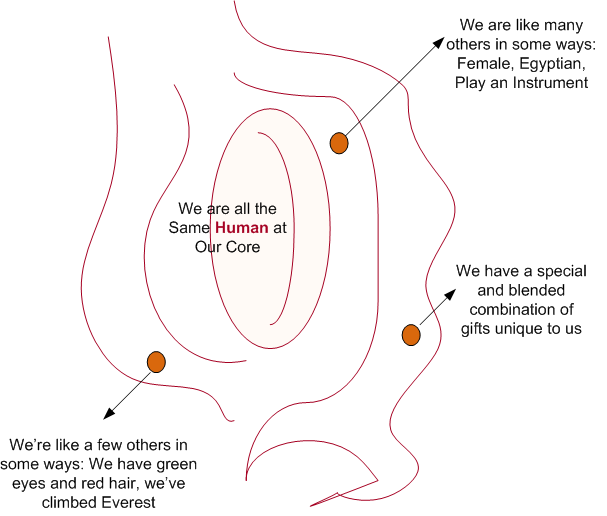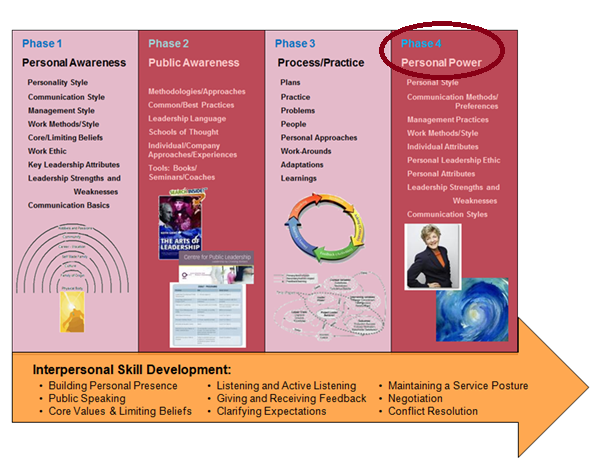Strong Point’s Leadership Rule #25: Lead Authentically
In Phase Four of Strong Point’s Leadership Development Methodology, leaders reach an authentic level of power in their personal and professional expression of leadership. Any one of us can learn to be truly authentic and lead others using our unique gifts when we’ve deeply learned about ourselves, really learned and refined our core skills and abilities, struggled through and owned our weaknesses and blind spots, and applied and mastered a whole host of business management methods developed by others.
“When you can truly understand how others experience your behavior, without defending or judging, you then have the ability to produce a breakthrough in your leadership and team. Everything starts with your self-awareness. You cannot take charge without taking accountability, and you cannot take accountability without understanding how you avoid it.”
Malandro, Fearless Leadership – Loretta
According to Strong Point’s Leadership Development Method, the first stage of development requires us to thoroughly audit our core skills, styles, strengths, values, and beliefs. Assessments of personality style, preferred management styles, commanding communication, learning, and critical thinking styles can be obtained, administered, and completed through a variety of online and traditional skills and style assessment vendors, institutions, and outlets. Phase One of leadership development requires that a leader-in-learning take a whole host of assessments and thoughtfully evaluate the results. Leaders in Phase One of development, work to gain a strong sense of their own self- image, as well as work toward concretely understanding the perceptions and impressions others have of them. This pursuit of self-knowledge continually poses the question “Who am I?” when learning leaders are faced with critical decisions, moral dilemmas, and professional conflicts and crossroads.
If you have a boss who challenges you, you must be able to articulate your style of leadership and say things like “Perhaps my belief in a blended approach requires more collaboration that you are comfortable with” and continue with bold questions such as: “ Do you think we can agree to sit down and develop a plan of action that provides you more comfort?” and work toward modeling collaborative action and intent with statements like: “I know once I understand your ideas and concerns better, we can find common ground and work toward synthesizing our needs and strengths.”
“Authentic leadership is leading adaptively from your core, choosing who you’re most inspired to be to serve the greatest good at this moment.”
Henna Inam, Wired for Authenticity: Seven Practices to Inspire, Adapt
Phase Two of Strong Point’s Leadership Development requires learning a core set of established professional methods. Strong Point’s Leadership Rule #24: Share Your Methods lists some of the foundational approaches and methods for which Strong Point advises gaining competency. A shortlist of those foundational methods are listed again here:
| Project/Program Management | Process Control |
| Business Analysis Skills | Quality Management |
| Software Development Life Cycle | Customer Engagement/Service Methods |
| Product Development/Design Thinking | Consultative or Product Selling |
| Lean/Six Sigma | Instructional Design Methods |
Strong Point recognizes that emerging leaders must learn and use as many of these time-tested and proven effective methods as is reasonable. It’s essential to become familiar with the implementation of leadership practices and principles in general. There’s such a core body of knowledge and shared expertise available in the public domain. Leaders are called and challenged to make the best and highest use of their time and talent, as well as leverage as much wisdom as possible and utilize as many tools and resources available to them. A core benefit of such a thorough methods study is the ability to recognize a disciplined approach and employ it when it’s needed!
An example benefit of methods study is illustrated in the March 2013 white paper called: Mixed Methods: Integrating Quantitative and Qualitative Data Collection and Analysis While Studying Patient-Centered Medical Home Models. This brief was prepared by Jennifer Wisdom, Ph.D., (George Washington University) and John W Creswell, Ph.D. (University of Nebraska, Lincoln) and focused on using mixed methods to evaluate patient-centered medical home (PCMH) models. The PCMH is a primary care approach that aims to improve quality, cost, and patient and provider experience. PCMH models emphasize patient-centered, comprehensive, coordinated, accessible care, and a systematic focus on quality and safety.
These researchers were funded to gather input from nationally recognized thought leaders in research methods and patient-centered medical home (PCMH) models and were challenged to expand the toolbox of methods used to evaluate, advance, and refine existing models. This kind of mixed-methods, methods-blending approach is often supported and facilitated by a Strong Point Solution Team, and indeed is often needed during a mission-critical business transformation effort.
It’s often the case, Strong Point has found, when several world-class organizations are working collaboratively to accomplish a single goal, they each bring their unique and distinct methods and ways of working to the effort. Sometimes, too, the ways of working are grounded in completely different strategies and approaches for producing the same desired result. Rather than compete and compare and bump through the collaborative effort, it’s most effective for Strong Point to offer facilitation support to the respective parties, so they can analyze, synthesize, blend and adapt their two disparate methods into a third, or “middle way” of working that is infinitely stronger than either existing method.
“Harmonizing opposites by going back to their source is the distinctive quality of the Zen attitude, the Middle Way: embracing contradictions, making a synthesis of them, achieving balance.”
Taisen Deshimaru
Dr. Wisdom’s and Dr. Creswell’s “mixed method” worked to integrate quantitative and qualitative data within a single investigative study or program of inquiry. The premise they used for mixing these methods was that the result of such data integration would produce a more comprehensive view of the patient care model and provide a more synergistic utilization of the separate quantitative or qualitative data sets. The result of the blend in methods and data sets produced meaningful advances in learning how to effectively implement a patient-centered medical home model as well as increased effectiveness in achieving the triple aim outcomes of the PCMH model: 1) reduced cost; 2) increased quality; and 3) elevations in the patient’s experience of care. None of these advances would have been possible without a strong methods foundation, study, or utilization.
Phase Three of Strong Point’s Leadership Development methodology is still focused on methods. In this Phase, the concentration is on “doing” not studying. It’s a phase of applied learning. This phase requires leaders in learning to exercise active implementation of industry methods: be they scientific test methods, program management methods, creative design or root cause analysis methods deployed to detect and solve persistent challenges.
Adam Malofsky, Ph.D., CEO, Managing Partner & President of Elemence Advisors – an Innovation, Materials & Assembly Consulting Practice, wrote an article in Innovation Excellence eMagazine called Want Great Insight? Then Experience Insight. Adam’s consulting company, Elemence Advisors, works to facilitate and accelerate innovation for its clients. Adam is a 25-year veteran of the performance chemicals, polymers, and materials industries. He’s held numerous leadership positions in a variety of companies and holds a passionate point of view concerning learning and leadership. His Insight article referenced above talks about how doing advances learning. He advises in his article:
“Listen, observe, and do. That develops context. Context delivers abstracted specifications. That’s where innovation transforms into ideas, invention, and delivery. That’s where the “What Must Be Trues” comes from that drive great insight.”
Adam Malofsky, PhD
In his article, Adam articulates what my Strong Point colleagues and I learn and live through every engagement. It’s this: You learn by doing. Strong Point’s Leadership Rule #19: Live It to Learn It validates and strengthens Strong Point’s belief that experiential learning is vital to strong leadership. Experiential learning, Adam Malofsky explains, and I completely agree, gives you context for the method you are working to strengthen and master. Working through the implementation of a scientific test method or a project plan teaches you how methods manifest into reality. Sometimes, the method or the plan you’ve designed is just actualized or realized differently than the way you’ve envisioned it. Just as often, outlined steps work better in a different sequence than the order you originally defined. When a leader or team repeatedly works through similar projects, they learn what specific parts of a Project Plan need to be built-out and what parts can be cut out. Actions become optimized through execution. Superfluous steps are sorted out and sluffed off. Predictability and purpose gain strength through execution. Phase Three of Strong Point’s Leadership Development Method is all about implementing and adapting other individuals’ or industry methods.

That brings us to Phase Four of Strong Point’s Leadership Development Model, and the main point of this blog: Authentic Leadership. Strong Point’s Leadership Rule #25: Lead Authentically.
If leaders work hard at getting to know themselves (Phase One) and learn to understand and use the vast array of existing leadership methods, techniques and practices already in use (Phases Two and Three), they can then begin to peel away the layers of skill and ability they possess and identify specific gifts and talents that are truly theirs and unique to them.
Underlying all of Strong Point’s Phases of Leadership Development is constant practice and improvement in interpersonal skills. Strong Point believes that learning and continually practicing core skills like: Body Language, Active Listening, Public Speaking, Clarifying Expectations, Negotiation and Conflict Resolution keep leaders focused on the people with whom they are working. Strong Point’s Leadership Rule #5: It Matters Who. It Matters How, reminds us of the fact historical data proves that businesses invest five to one in Business Capability and Technology Advancements vs. Leadership Development and individual and team skill development and Performance Capability.
Leaders who make it to Phase Four of Leadership Development become authentic leaders.

Authentic Leaders:
enable emotional openness and allow vulnerability. They make mistakes and won’t shame you or blame you if you make one. they are warm and friendly and loving. They laugh at themselves and are ever respectful of others. give freely of their time, energy, talent, and support. are trusted experts. You know they have worked hard. They are deeply disciplined. They continue to work hard. explain motives, decisions, thought process and reasoning to promote understanding. teach as much as they learn. don’t lead in a vacuum. The ideas that drive their work come from their bosses, colleagues, subordinates, peers, trusted advisors, partners and mentors. use mindfulness to Stay awake! And Stay present. They do whatever is needed to “be” with people during the time they have together. are congruent in mind, body, spirit. They do not compartmentalize actions or behavior. They act in the same predictable manner, whether they are working, at the airport or with their kids. look forward, always, and have a growth mindset. write their goals, values and beliefs down, and articulate them!! They keep them in front of themselves and others!! ask questions and listen more than they talk. They are interesting because they are interested in others.
Strong Point strives to Lead Authentically and to develop Authentic Leaders.
Strong Point’s Leadership Rule #25: Lead Authentically



